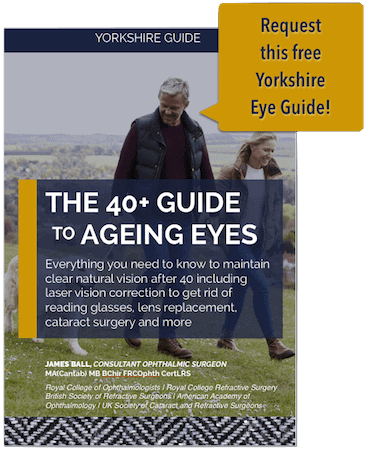
Presbyopia treatment: How does PRESBYOND laser blended vision work?
How does PRESBYOND blended laser vision work? Well what we do is always begin with the patient’s lifestyle and their eyes. We not only look at the spectacle prescription, which we always do with any laser eye surgery but also we look at an imperfection in their optical system called a spherical aberration. The reason we want to measure that before we touch the patient’s eyes is that we are going to use that imperfection.
Now to a lot of eye surgeons, optometrists and people working optical profession feel quite wrong to talk about an imperfection this way. We have been conditioned a lot by the industry, by lens manufacturers and optical machine manufacturers to be on a quest for perfect optics. It makes sense that we want always to be creating a perfectly sharp image for our patients. If we were looking after someone who’s around 25 years old and they’ve got wonderful full accommodation and ability to shift focus then absolutely we can go for completely crisp sharp focused optics and crisp focusing distance and the patient will then do the hard yards. They’ll move the image for us backwards and forwards focusing on the thumbnail at near distance and back out again.
But as soon as we’re looking after someone is over the age of 40 we’ve lost some of that ability. As soon as we’re looking after someone who is over the age of 50 we’ve lost a lot of that ability. If we create perfect sharp optics for that patient out in the distance, they will be on and off with their readers all the time because they can’t bring the focus in. We want to deliberately create a small amount of imperfection. We use spherical aberration because our brains are used to it. It’s an imperfection which forms part of the accommodation. We know how to tune it, and we can accept a little bit of spherical aberration. Our brains will sharpen up and give us a nice crisp image.
What that then allows us to do, is to increase the depth of focus on each eye. And if all we did was increase the spherical aberration, the depth of focus on both eyes for distance, we’ve done a pretty good job actually for a patient who is 50. We would make their intermediate vision quite good, they will be able to see what they’re eating without specs, which maybe doesn’t sound like a big deal, but if we credit perfect crisp, sharp distance vision, they have to put readers on and off, just to see their food.
If we then make one eye just slightly short sighted in combination with an increased depth of focus, the two eyes are overlapping to a significant extent, so that the intermediate vision in both eyes are bringing some vision to the party. But then the short-sighted eye we brought in a little bit can boost that near vision significantly. So now we have a person who can you can read, see the time on the watch, send texts on the phone or look at the menu and they’re not just saying “I’ll have the fish”, because they have no idea what’s on the menu or can’t specials board on the other side of the restaurant. They are actually reading the menu, and they’re making a considered choice based on what they feel like having read all the choices.
We can achieve that range of focus by deliberately creating a small controlled amount of imperfection in spherical aberration on each eye to create a range of focus. It’s still a good level vision; it really is, these patients have twenty-twenty vision. It’s an incredibly powerful tool to give people a great range of focus in their fifties, when many patients still have a very clear lens inside their eyes, so they don’t have any sign of a cataract.
But also these patients are future-proofed. So let’s fast-forward them to their seventieth-birthday and let’s say they now have some significant cataract. The quality of vision is not so good, and they’ve lost the sharpness of vision. They could have completely simple but elegant cataract surgery with a neutral lens that just gets rid of the cloudiness and restores the quality and the PRESBYOND blended vision will be reanimated. It will always work again.
Let’s fast-forward 20 years and imagine I’m not using the technology that I’m using now because it’s likely to move forward. Let’s say Google, Apple or one of the big tech giant’s has created a perfect human replacement lens that accommodates and that flexes like our lenses do when we were in our twenties. My patient can have that, and the PRESBYOND blended vision curvature on the cornea will not compromise that in any way shape or form. In fact, you’d probably just get rid of the difference in the eyes at that stage and set both eyes out for distance, and it really would be like being 21 years old again with a lens reflex.
I find that a very attractive feature of PRESBYOND blended vision for patients who have no sign of cataract, the right prescription, and a good tear film. It’s a lovely option for now, and it provides great function. But I know I have future-proofed them. I know that when I retire, I set them up, so that they can, with a variety of different approaches, carry on enjoying great vision even if they need cataract surgery later in life.



